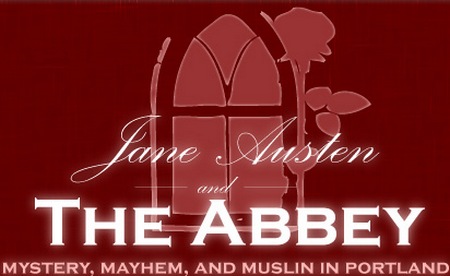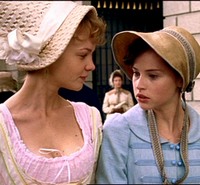I am all anticipation! Tomorrow (now today) I will be on my way to the Jane Austen conference in Portland to celebrate three days of total Austen immersion. Jane Austen and the Abbey: Mystery, Mayhem and Muslin in Portland begins officially on Friday, October 29th and runs through Sunday, October 31th. This is my first... Continue Reading →
Northanger Abbey (2007) Encore on Sunday
Don’t miss the encore presentation of Northanger Abbey (2007) on Masterpiece Classic PBS Sunday, February 14th 9:00 – 10:30 PM (check your local listings). This adaptation by screenwriter Andrew Davies stars Felicity Jones as Jane Austen’s idealistic and naïve heroine Catherine Moreland and JJ Feild as the charming and witty hero Henry Tilney. Northanger Abbey... Continue Reading →
Collector’s Library Re-issues Jane Austen Classics
Great news for Jane Austen readers and book collectors. The Collector's Library, a UK publisher has re-issued their popular and distinctive editions of Jane Austen’s six major novels. These compact 5.9 x 4 inch volumes are beautifully designed for easy handling and include these great features: Full-cloth hardcover bindings Ribbon markers Head and tail bands Gilt... Continue Reading →
The Temptation of the Night Jasmine: A Pink Carnation Novel (Book 5), by Lauren Willig – A Review
In the fifth installment in her Pink Carnation Series, more Napoleonic espionage ensues as Lauren Willig spins her captivating tale of the exploits of Robert Lansdowne, the reluctant Duke of Dovedail, and his bookish young cousin Charlotte in The Temptation of the Night Jasmine. Set in England in 1803, Robert’s unexpected return to his ducal estate... Continue Reading →
Northanger Abbey Chapters 29-31: Summary, Musings & Discussion: Day 20 Giveaway
On entering the room, the first object she beheld was a young man whom she had never seen before. With a look of much respect, he immediately rose, and being introduced to her by her conscious daughter as "Mr. Henry Tilney," with the embarrassment of real sensibility began to apologize for his appearance there, acknowledging... Continue Reading →
Go Gothic with Northanger Abbey: Gothically Inspired: Day 19 Giveaway
"The person, be it gentleman or lady, who has not pleasure in a good novel, must be intolerably stupid. I have read all Mrs. Radcliffe's works, and most of them with great pleasure. The Mysteries of Udolpho, when I had once begun it, I could not lay down again; I remember finishing it in two... Continue Reading →
Northanger Abbey Chapters 25-28: Summary, Musings & Discussion: Day 18 Giveaway!
The visions of romance were over. Catherine was completely awakened. Henry's address, short as it had been, had more thoroughly opened her eyes to the extravagance of her late fancies than all their several disappointments had done. Most grievously was she humbled. Most bitterly did she cry. It was not only with herself that she... Continue Reading →
Go Gothic with Northanger Abbey: Catherine Morland’s Experience in Bath Part 4
if adventures will not befall a young lady in her own village, she must seek them abroad Beechen Cliff, the Arts, and Natural Surroundings at Jane Austen's World Take a walk through the countryside of Bath with Ms. Place (Vic) as she continues to explore heroine Catherine Morland's experience in Bath with her excellent... Continue Reading →
Go Gothic with Northanger Abbey: Guest Bloggers Trina Robbins & Anne Timmons Chat about Gothic Classics: Day 17 Giveaway!
Think of Northanger Abbey in a graphic novel format with all of its energy and Gothic allusions visually popping right off the page, and you will have a good notion of what author Trina Robbins and illustrator Anne Timmons have created in their frightfully enchanting version of Northanger Abbey included in Gothic Classics: Graphic Classics Volume... Continue Reading →
The Sunday Salon: Preview of Oxford World’s Classics: The Mysteries of Udolpho by Ann Radcliffe: Day 16 Giveaway
Her present life appeared like the dream of a distempered imagination, or like one of those frightful fictions, in which the wild genius of the poets sometimes delighted. Reflection brought only regret, and anticipation terror. How often did she wish to "steal the lark's wing, and mount the swiftest gale," that Languedoc and repose might... Continue Reading →
Northanger Abbey Chapters 18-21: Summary, Musings & Discussion: Day 13 Giveaway
"Psha! My dear creature," she replied, "do not think me such a simpleton as to be always wanting to confine him to my elbow. It would be hideous to be always together; we should be the jest of the place. And so you are going to Northanger! I am amazingly glad of it. It is... Continue Reading →
Go Gothic with Northanger Abbey: Catherine Morland’s Experience in Bath Part 3
if adventures will not befall a young lady in her own village, she must seek them abroad Lower Assembly Rooms and Bath Society at Jane Austen's World Discover the Lower Rooms in Bath where Catherine Morland the heroine of Northanger Abbey is introduced by the Master of Ceremonies James King to "a very... Continue Reading →











